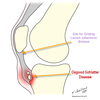GetAhead Surgery SBAs Flashcards
What’s the investigation in suspected causes of Myasthenia Gravis?
Tensilon test
*Tensilon = trade name for edrophonium bromide (short acting anti-cholinesterase)
- when administrated IV -> sudden improvement in muscle weakness (prolonged action of acetylcholine is allowed)
What’s a typical Rx of PID?
2 weeks of :
- Ofloxacin (anti-chlamydia and gonorrhoea) and
- Metronidazole (anti- anaerobes and protozoa)
*if significant systemic upset - IV antibiotics
What’s Fitz- Hugh- Curtis syndrome?
RUQ pain caused by inflammation of connective tissue around the liver by the pelvic infection (e.g. in PID)
What’s Herpes Simplex Keratitis?
- detection
- symptoms
- treatment
Infection of the cornea with Herpes Simplex Virus (HSV)
- it may be present after many years of first HSV encounter (dormant in the trigeminal nerve)
- Symptoms: painful, watery, red eye
corneal injection,
- Detection: cobalt blue light with fluorescein -> branch-line lesion= dendritic ulcer that contains live virus
- Treatment: aciclovir until an ulcer heals
- Complications: risk of corneal scarring and blindness -> urgent ophthalmological assessment is needed
*steroids are contraindicated - as they weaken immune system and increase viral burdne

What’s a triad of Budd-Chari syndrome?
- abdo pain
- hepatosplenomegaly
- ascities
*it’s venous flow obstruction secondary to thrombosis of hepatic vein
What’s ABCD2 score?
scoring / results
ABCD2 following TIA
A → age > 65 (1 point)
B → Blood pressure systolic >140 or diastolic >90 (1 point)
C → unilateral weakness (2 points), speech disturbance (1 point)
D → duration >60 minutes (2 points), 10-59 minutes (1 point)
D → diabetes (1 point)
Results: (total score 7)
- 4 or more → admission for inpatient assessment (re suitability for carotid endarterectomy)
Who needs an urgent admission following TIA? (2)
- 4 or more → admission for inpatient assessment (re suitability for carotid endarterectomy)
- Two or more episodes of TIA in a quick succession ‘crescendo TIA’) → need urgent admission regardless of ABCD2 score
What’s March fracture?
- undisplaced hairline fracture
- caused by repetitive stress e.g. marching, running
- common sites: neck of 2nd or 3rd metatarsal
- X ray mostly normal
- periosteal reaction (formation of a new bone/callus in response to stimuli) may be seen
- Rx: analgesia → pain resolves after few weeks (as the fracture union occurs)
What’s Marjolin’s ulcer?
- aggressive but slow - growing squamous cell carcinoma
- arises from the area of previously traumatised skin (e.g. scars, burns)
- lesions: ulcerated, raised and painless
- invade locally
- Dx: biopsy
- Rx: wide local excision

Hypertrophic vs keloid scars
Both occur when there is overgrowth of fibrous tissue within a healing scar
Hypertrophic:
- raised lesions
- within boundary of the original scar
Keloid:
- beyond original scar
Haemorrhagic Shock Class I criteria

Haemorrhagic Shock Class II criteria

Haemorrhagic Shock Class III criteria

Haemorrhagic Shock Class IV criteria

What’s Osler-Weber-Rendu syndrome?
Aka Hereditary Haemorrhagic Telangiectasia
- Autosomal Dominant condition
- Characteristics: telangiectasia, AV malformations at multiple sites, recurrent epistaxis
- Other problems: GI bleeds, hemoptysis, resp compromise due to AV malformations in the lungs, haemorrhagic strokes
- 10% patients have neuro features: headaches, seizures
What features would be suggestive that there is no C-spine injury (when can we remove C - spine collar)?
- patient is not drunk and not under the influence of any drugs
- patient is alert and oriented
- no head injury
- no neck pain
- no abnormal neurology
- no C- spine tenderness or deformity
*if any of these are present → must do imaging
* life- saving procedures take priority over C-spine injury
Adrenaline as local anaesthetic
- MoA
- contraindications
- MoA: Adrenaline will constrict the arteries → prolong the action of local anaesthetics by slowing down system absorption
- Contraindications: end arteries e.g. penis, nose and digits (due to risk of ischaemic necrosis)
Pseudobulbar vs bulbar palsy
Pseudobulbar
- bilateral UPPER motor neurone lesion (9th and 12th CN)
Bulbar
- bilateral LOWER motor neurone lesion (9th and 12th)
How long would it take for the fracture to heal?
- upper limb
- lower limb
- upper: 6-8 weeks
- lower: 12-16 weeks
*these numbers are halved in children
What’s Mackler’s triad?
- vomiting
- lower thoracic/chest pain
- subcutaneous emphysema
Suggestive of Boerhaave’s syndrome → a spontaneous transmural rupture of the oesophagus
What’s the triad of Zollinger-Ellison syndrome?
- gastrin-producing tumour
- gastric hypersecretion
- severe peptic ulceration
Rx: PPIs and tumour resection
What’s Maydl’s hernia?
- Hernia that contains ‘W’ loop of intestine within its sac
- Middle segment is liable to become strangulated

What’s a gluteal hernia?
- protrudes through a greater sciatic foramen
- results from the weakness or deficiency of gluteal muscle fibres










